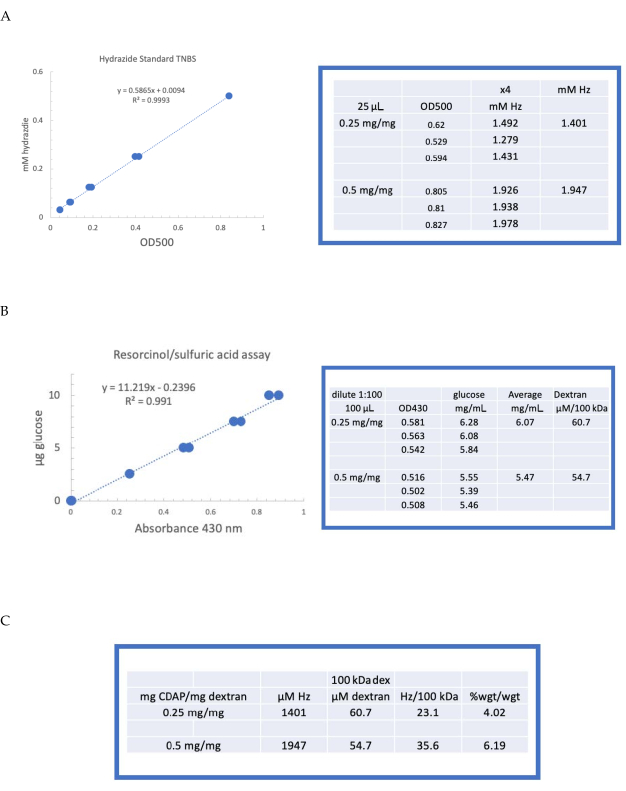Abstract
Immunology and Infection
Aktivierung und Konjugation löslicher Polysaccharide unter Verwendung von 1-Cyano-4-Dimethylaminopyridintetrafluoroborat (CDAP)
ERRATUM NOTICE
Important: There has been an erratum issued for this article. Read more …Konjugierte Impfstoffe sind bemerkenswerte Fortschritte in der Vakzinologie. Für die Herstellung von Polysaccharid-Konjugat-Impfstoffen können die Polysaccharide mit 1-Cyano-4-Dimethylaminopyridintetrafluoroborat (CDAP), einem einfach zu handhabenden cyylierenden Reagenz, bequem funktionalisiert und mit Impfstoffträgerproteinen verknüpft werden. CDAP aktiviert Polysaccharide, indem es mit Kohlenhydrathydroxylgruppen bei pH 7-9 reagiert. Die Stabilität und Reaktivität von CDAP sind stark pH-abhängig. Der pH-Wert der Reaktion sinkt auch während der Aktivierung aufgrund der Hydrolyse von CDAP, was eine gute pH-Kontrolle zum Schlüssel für eine reproduzierbare Aktivierung macht. Das ursprüngliche CDAP-Aktivierungsprotokoll wurde bei Raumtemperatur in ungepufferten pH-9-Lösungen durchgeführt.
Aufgrund der schnellen Reaktion unter dieser Bedingung (<3 min) und des damit einhergehenden schnellen pH-Abfalls aus der schnellen CDAP-Hydrolyse war es schwierig, den Zielreaktions-pH-Wert in kurzer Zeit schnell anzupassen und aufrechtzuerhalten. Das hier beschriebene verbesserte Protokoll wird bei 0 °C durchgeführt, was die CDAP-Hydrolyse verlangsamt und die Aktivierungszeit von 3 min auf ~15 min verlängert. Dimethylaminopyridin (DMAP) wurde auch als Puffer verwendet, um die Polysaccharidlösung vor der Zugabe des CDAP-Reagens an den pH-Wert der Zielaktivierung anzupassen. Die längere Reaktionszeit, gepaart mit der langsameren CDAP-Hydrolyse und der Verwendung von DMAP-Puffer, erleichtert die Aufrechterhaltung des Aktivierungs-pH-Werts für die gesamte Dauer des Aktivierungsprozesses. Das verbesserte Protokoll macht den Aktivierungsprozess weniger hektisch, reproduzierbarer und skalierbarer.
Erratum
Erratum: Activation and Conjugation of Soluble Polysaccharides using 1-Cyano-4-Dimethylaminopyridine Tetrafluoroborate (CDAP)An erratum was issued for: Activation and Conjugation of Soluble Polysaccharides using 1-Cyano-4-Dimethylaminopyridine Tetrafluoroborate (CDAP). A figure was updated.
Figure 4 was updated from:

Figure 4: Representative results for CDAP activation of dextran. Typical standard curves for the (A) resorcinol/sulfuric acid and (B) TNBS assays. The assay results for dextran activated with 0.25 and 0.5 mg CDAP/mg dextran are shown. Glucose was used as the standard for the resorcinol assay. Dextran, in mg/mL, is divided by 100 kDa to give a molar concentration. The hydrazide concentration is determined using ADH as the standard and the results expressed as µM Hz. (C) Calculation of hydrazide: dextran ratios.The level of derivatization was calculated as hydrazides per 100 kDa of dextran to facilitate the comparison between polymers of different average molecular weights. The % weight ratio of g ADH/g dextran was calculated using a MW of 174 g/mole for ADH. Please click here to view a larger version of this figure.
to:

Figure 4: Representative results for CDAP activation of dextran. Typical standard curves for the (A) resorcinol/sulfuric acid and (B) TNBS assays. The assay results for dextran activated with 0.25 and 0.5 mg CDAP/mg dextran are shown. Glucose was used as the standard for the resorcinol assay. Dextran, in mg/mL, is divided by 100 kDa to give a molar concentration. The hydrazide concentration is determined using ADH as the standard and the results expressed as µM Hz. (C) Calculation of hydrazide: dextran ratios.The level of derivatization was calculated as hydrazides per 100 kDa of dextran to facilitate the comparison between polymers of different average molecular weights. The % weight ratio of g ADH/g dextran was calculated using a MW of 174 g/mole for ADH. Please click here to view a larger version of this figure.
ABOUT JoVE
Copyright © 2024 MyJoVE Corporation. All rights reserved